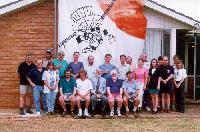The Parkes radio telescope tracking the Galileo spacecraft around the Planet Jupiter. Venus can be seen setting to the left of the dish - 6 November 1997.
The Final Galileo Operations Report - November, 1997
The Parkes radio telescope tracking the Galileo spacecraft around the Planet Jupiter. Venus can be seen setting to the left of the dish - 6 November 1997. |
The Galileo tracking operations commenced at Parkes on 4 March 1996, and finished on 6 November 1997.
The trial tracking period, of 48 tracks, extended from 4 March 1996 to 24 October 1996.
The contracted tracking period ran from 28 October 1996 to 6 November 1997, and involved 7-day per week operations. During the contracted period, there were three short breaks in the tracking commitment :-
13 Jan. 1997 - 27 Jan. 1997 (inclusive) Solar Conjunction
19 Aug. 1997 - 9 Sep. 1997 (inclusive) Opposition
25 Sep. 1997 - 30 Sep. 1997 (inclusive)
The last two listed breaks were contracted in order to allow "normal" astronomy of high priority to proceed.
2. Galileo Operations Staff
Galileo tracking was undertaken principally by three Galileo operators; Dr. Ian Stewart, Mr. Russell Pace and Mr. John Sarkissian.
Five members of the observatory technical staff were also trained as Galileo operators; Dr. Paul Payne, Mr. Euan Troup, Mr. Barry Turner, Mr. Martin McColl and Mr. Rick Twardy.
During the trial tracks period, several other staff performed Galileo tracks. They were Mr. Niven Tasker, Mr. Harry Fagg, Mr. Brett Preisig, Dr. Peter te Lintel-Hekkert, Mr. John Glowacki and Mr. Greg Cooke.
Initial management of the Galileo operations was undertaken by Dr. Paul Payne, with overall direction provided by Mr. Peter Hall. With the return of Dr. Alan Wright as Operations Head, in December 1996, Galileo operations were integrated with astronomy and related programs. On the departure of Dr. Payne on 28 February 1997, Mr. John Sarkissian took over the day-to-day co-ordination of the Galileo operations.
During out-of-hours Galileo tracks, designated contact person (DCP) responsibilities were shared between Dr. Peter te Lintel-Hekkert, Dr. Ian Stewart, Mr. Euan Troup and Mr. Gareth Banks.
3. The Tracking Duties
Once the contracted tracking period had commenced, the tracks progressed smoothly through out. The period from November to January saw quite a few hours of track time lost because of wind stows. Moths in the ME room also contributed to lost track time, though this was very minor, and confined mainly to the warmer months when moths were more prevalent.
As the year progressed, the starting times of the tracks migrated through the civil day at a near sidereal rate. Prolonged periods of working at very odd hours, caused concern for some of the operators. The shifts were accordingly re-organised to reduce the impact on family life.
During the contracted tracking period, no track time was ever lost due to observatory equipment failure. Operator errors were reduced to nil as a result of increased experience and competence.
The most frequent cause of concern was the performance of the Full Spectrum Resolvers (FSR's). The observatory had two installed - FSR5 and FSR6, with FSR6 being the backup. FR6 frequently had problems with its tape drives, and often had to be rebooted, on request from Tidbinbilla. FSR5 was enormously more reliable and we experienced very little problems with it. The Router also caused some problems, but these were fixed early in 1997.
Early in 1997, JPL installed a Block Five Receiver (BVR), as a backup for its FSRs. However, it was never fully functional, and it was removed shortly there after.
In late September, 1997, during the scheduled break in tracking duties, the x14 Multiplier Unit of the observatory's hydrogen maser clock failed. A replacement unit was quickly shipped in from JPL in California, and installed just hours before the tracks were scheduled to resume. Fortunately for us, the Mars PathFinder probe was experiencing communications problems at this same time. Galileo tracking duties were suspended for a short time to enable the 70 metre dish at Tidbinbilla to be used in re-establishing contact. This little extra time allowed us to have the multiplier unit installed without losing any track time.
The end point of the Parkes Galileo tracking duties was brought forward to November 6, 1997 from the originally planned date of November 30, 1997.
4. Statistics
(minutes) |
(minutes) |
(minutes) |
||
The overal uptime was 96.95 %. The contract specification was for 96.25 %. Despite earlier pessimistic forecasts, we were easily able to meet our contract specification.
Of the total downtime of 3.05 %, wind accounted for 92.28 % of the time. The period from November to January is the windiest at Parkes, and this is reflected in the significantly reduced uptime percentage for that period.
5. Commendation
 Celebrating the end of the Galileo tracks. Parkes Observatory staff - 14 November 1997. |
John, Len and all CSIRO personnel at Parkes/CDSCC: Your efforts have truly been amazing and ever-so professional throughout the past few years, and from my viewpoint, especially during array operations over the past year. It has been thrilling to watch your performance. I know Galileo and NASA are thoroughly pleased with the return on investment. The teamwork and willingness to "go the extra mile" as we say over here have been most appreciated. Thanks for all the hard work. Regards, Patrick E. Beyer TMS Manager for Galileo
6. Other Galileo Links
 JPL's Galileo Home Page (for all the latest information).
JPL's Galileo Home Page (for all the latest information).
 The Jet Propulsion Laboratory Home Page.
The Jet Propulsion Laboratory Home Page.
 CSIRO Media Release - "Parkes Telescope to rescue Jupiter Mission".
CSIRO Media Release - "Parkes Telescope to rescue Jupiter Mission".
 NASA Press Release - "NASA links antennas to maximise data return".
NASA Press Release - "NASA links antennas to maximise data return".
November, 1997
John M. Sarkissian
Co-ordinator of Galileo Tracking Operations
Parkes Radio Observatory,
CSIRO Australia Telescope National Facility